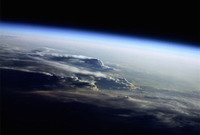Scientists observe rapid accumulation of greenhouse gases
The National Oceanic and Atmospheric Administration estimated that greenhouse gases were accumulating faster than was expected despite efforts to reduce the emission.

The concentration of carbon dioxide in the air went up by 2.4 parts per million, and methane concentrations rose by 27 million tons last year.
Greenhouse gases are essential to maintaining the temperature of the Earth, without them the planet would be so cold as to be uninhabitable. However, an excess of greenhouse gases can raise the temperature of a planet to lethal levels, as on Venus where the 96.5% carbon dioxide (CO2) atmosphere results in surface temperatures of about 467 °C (872 °F).
Based on ice-core samples and records (see graphs) current levels of CO2 are approximately 100 ppmv higher than during immediately pre-industrial times, when direct human influence was negligible.
Carbon dioxide, methane, nitrous oxide and three groups of fluorinated gases are the major greenhouse gases and the subject of the Kyoto Protocol, which came into force in 2005. Kyoto agreement is to encourage countries to take steps to reduce their greenhouse emissions. Some countries, particularly in Europe , have taken steps to reduce emissions.
But carbon dioxide emissions, primarily from burning fossil fuels such as coal, oil and gas have continued to increase.
Since the beginning of the Industrial Revolution, the concentrations of many of the greenhouse gases have increased. The concentration of CO2 has increased by about 100 ppm (i.e., from 280 ppm to 380 ppm). The first 50 ppm increase took place in about 200 years, from the start of the Industrial Revolution to around 1973; the next 50 ppm increase took place in about 33 years, from 1973 to 2006. Many observations are available on line in a variety of Atmospheric Chemistry Observational Databases.
Photo: www-airs.jpl.nasa.gov
Subscribe to Pravda.Ru Telegram channel, Facebook, RSS!


